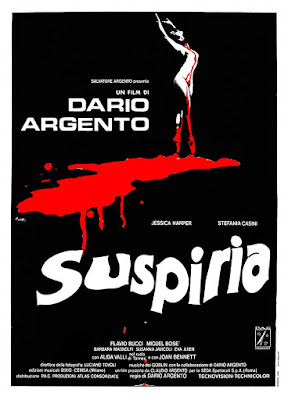Now we have a new Suspiria with music from Thom Yorke and
an all new take on the tale it felt I was long overview a trip to see this in
the Prince Charles Cinema just off Leicester Square which led me to purchasing
the Blu-ray restored version and to ditch my off-TV VHS recording. I’ve
previously raved about Dario Argento’s directorial style on The Bird with the
Crystal Plumage, and here he is in overdrive with a film packed full of
high-quality atmospherics, visceral set design and some extraordinary
cinematography from Luciano Tovoli.
Even though there are some graphic segments, there’s so
much more uneasiness created by the controlled build up of tension and the
casting of the odd and unusual figures; the old women who work in the dance
school, the young boy in a period satin pageboy suit, a giant servant who looks
so much less fearsome after recent dental work (ha, Dario, ha-ha) and the blind
pianist with the Doberman guide dog…
The sets are extreme, like Chitty Chitty Bang Bang on the baddest of trips with reds and
yellows, and blocks of deep blue all marking the environment as in-human and
uncomfortable. The dancing school sweet Suzy Bannion (the perfectly-cast
Jessica Harper) finds herself in is just about believable, but those colours
paint a warning from the start.
Tovoli’s camera makes the absolute most of these gifts
with acute angles, and massive overhead shots that seem to encompass impending
doom whilst at the same time giving the viewer fleeting re-assurance that we’ll
be above it… it’s so cruel as we’ll soon be down watching the blood flow and
the flesh get ripped.
Then there is the director’s superb use of the score; a
character in its own right, that bustles, buzzes and moans creating tension
throughout always reverting to a spine-tingling main theme that is not prog
exactly but a foretaste of modern composition used ever since. It’s not quite
what I expected and genuinely feels out of time, as indeed, does the film.
 |
| Jessica Harper, Alida Valli and Joan Bennett |
But nothing sends signals quite like the behaviour of odd
people and Agento has brought out the disquiet in all of his performers. Even
when, in searching for her missing friend, Sara (Stefania Casini), Suzy goes to
talk to a psychologist who knows her Dr. Frank Mandel played with a strange
intensity by a coca cola guzzling Udo Kier. The conversation is framed by an
overhead shot showing the vast, ultra-modern university as if from the wings of
a dark bird of prey, the camera swooping closer in as if the two are being
watched… there’s no “comfort breaks” in this film and we’re pulled relentlessly
on.
The film begins in a downpour as Suzy arrives in Munich
to discover that the very elements seem to be against her… this foreshadowing
is nothing compared to the reception she gets at the school as a young woman
pushes past her and runs off screaming as if pursued by the hounds of hell.
Suzy’s finally welcomed by the senior staff at the Tanz Dance Academy,
instructor, Miss Tanner (the excellent Alida Valli) and the headmistress,
Madame Blanc (*the* Joan Bennett no less…).
She meets the other students, friendly Sara and alpha school bully Olga
(Barbara Magnolfi) who she gets to share an apartment with in town.
It's all very off-kilter and deliberately unsettling with
director and musicians hitting the viewer with shock and unease; there’s no
time to settle in a film when almost everyone our heroin meets is weird.
Suzy joins the ballet school but what she has not seen is
the subsequent death of the girl she met, Patricia Hingle (Eva Axén) who has been
killed by unseen forces along with a friend… you can leave the school perhaps
but you cannot escape the forces within.
Soon, Suzy herself is overcome by a strange illness and
the school doctor, Professor Verdegast (Renato Scarpa) decides that Suzy's anaemia
is to be treated with a regular glass of red wine or, something that looks like
red wine. Suzy soon finds out more unsettling gossip from Sara as weird events
continue such as an infestation of maggots falling down on the girls’ hair
which forces them to sleep in the hall where they hear the most revolting snores
from an ancient sleeper nearby…
Then Sara goes missing and as Suzy seeks answers from Mandel,
she hears of how the school was established by a Greek woman named Helena
Markos, who locals believed was a witch. Markos supposedly perished in a fire
that destroyed most of the school but, as one of Mandel’s colleagues Professor
Milius, explains, a coven is unable to survive without its leader… could it be
that witchcraft governs the Academy still?
Well, what do you reckon…?
Dusty Verdict:
Suspiria is stone-cold classic of
period horror that more than stands the test of time due to the quality of
design, soundscapes and direction; a genuine art-house success
The film was based on Suspiria
de Profundis by Thomas De Quincey and I look forward to reading that
*after* watching the Luca Guadagnino 2018 version for comparison: no matter how
good it is I find it hard to think it’ll be as uncanny and unsettling as
Argento’s relentless and unpredictable atmospherics.




































